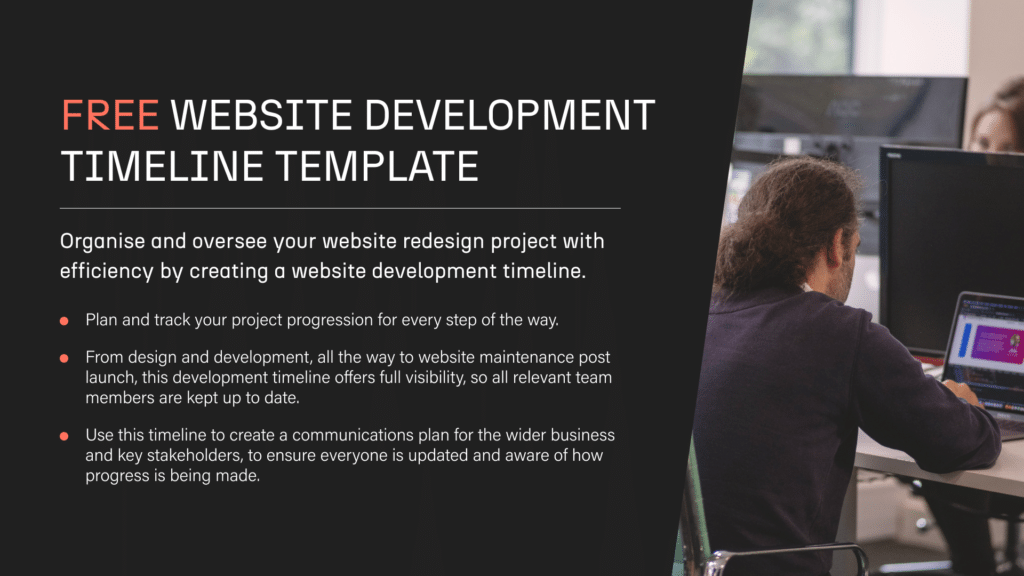How to Put Together a Website Development Timeline & Communications Plan [with Template]
You’ve envisioned what that shiny new website should look like. You’ve done your research into how it’ll benefit the business, gathering key stats and figures to prove it. You’ve taken these same stats to your stakeholders and you’ve been given the go ahead. Now you’re ready to get cracking with a website that’s going to knock the socks off both your colleagues and your competitors.
Well, not so fast. Only fools rush in – especially where proper website development is concerned. Whatever the size and scope of your website is, knowing what you need to do and at what time gives your team a path that everyone can stick to. Basically, by mapping everything out at the start of the project, the route you take will be a lot less rocky than if you don’t.
You can also double the effectiveness of your website development timeline with a communications plan to ensure that the team, and the whole business, stays in the loop and on track over the course of the project. We’ll walk you through how to create them both – complete with your very own website development timeline template to download – over the course of this in-depth article here.
Quick Navigation
- Website plan approval
- The next stages of website development
- How to map out a website development plan timeline
- Creating a communications plan
Website plan approval
Once your website plans have been approved
Now that your website plans have got the green light, you’re ready to take the next steps in the project. But before you go in feet first, knowing what you need to do – and who’s going to help you – is vital. Ahead of any actual work on the site itself, think about what each stage of the web project will involve, the length of time each will require and which team members you’ll bring in to ensure the project continues as smoothly as possible.
The next stages of website development
Web design
You’ll have a bevy of information and research from your strategy stage that’ll help inform the look of your website. Over the course of this 4-to-12-week phase, you’ll create mock-ups of key pages in both desktop and mobile views, detail a sitemap, and get the lay of the land when it comes to all-things appearances.
Development and coding
With designs approved, you can now get to work on the development and coding stage, a process that takes anywhere from 5 to 15 weeks, depending on the number of pages your site has. If any custom web applications, integrations or tools are also needed, then be sure to account for these, as such techy bells and whistles can make this phase or the project even longer.
Content migration
Creating new content, and migrating what’s already been written, is another lengthy process – but one that’s well worth carrying out. Here, you’ll need to express your business’ key messages, create calls to action to keep the customer journey moving, write up powerful page titles and headings that’ll have people clicking and soup up everything with quality SEO. Depending on size and scope, this can be anywhere from 6 to 15 weeks…
Testing and QA
With your content created and migrated, you’re good to go with the beta testing stage to make sure everything is fully functional across different devices, screen sizes and web browsers. This phase, which generally takes between 2 to 6 weeks, will also ensure that the site looks and moves like you envisioned at the discovery stage.
Launch
Once the beta testing has been completed and you’re happy with how everything looks and feels, it’s time to launch your shiny new website. Depending on the complexity of the site, this can take anywhere from 1 day to 2 weeks.
How to map out a website development timeline
Setting timeline goals
With so many moving parts, goals and milestones are going to keep everything moving in the right direction. With nothing to drive towards, the project will end up lacking focus and discipline, which is when deadlines, milestones and goals pass by without completion. By creating realistic, achievable goals, you and your team can stay the course with, hopefully, minimal upsets and incidents.
Cross-team collaboration
You stand a better chance of achieving your goals when you have an experienced team to rely on throughout the project. To maximise cross-team collaboration, you’ll need to know who will be available ahead of time. Whether they’re on annual leave or busy with other projects, the last thing you want to happen is to find out your lead designer’s jetting off on a two-week hol before the design phase is set to take place.
Use our shareable website development timeline template
When all of your goals and required actions are in one place, it helps to keep everyone who’s involved on the same page. Using our downloadable template, you’ll be able to streamline the progress of your project, creating a clear, easy-to-follow timeline that provides an overview of everything you have planned.
Start your project off on the right foot – download your shareable website development timeline template here.
Download Your Free Website Development Timeline Template

Creating a communications plan
Why do you need a communications plan?
A communications plan can be a powerful tool in a project manager’s arsenal, one that has a huge role to play in establishing and encouraging the employee behaviours and actions that’ll achieve the outcomes laid out at the outset.
What are the goals of the communications plan?
Ultimately, a communication plan is all about helping you achieve the results you’re aiming for. But more specifically, a communications plan will keep your team informed and engaged by addressing the rationale of your website project, detailing relevant insights you unlocked at the research, discovery and testing stages and, of course, lay out any schedules and milestones you want to stick to and hit during the project’s lifespan.
Who will benefit the most from the communication?
The audience of your communications plan can be as broad or as narrow as you want it to be, as long as you feel it’s beneficial to them, the plan could well be relevant to anyone within the business. Anyone you feel should be informed and engaged about the project is going to be fair game.
If you want to be more specific if your approach, then think about whether there are specific people you want to bring together and strengthen the working relationship between, too. This is a great way of increasing the collaboration that we mentioned earlier.
What form of communication is best to use?
It depends on who your audience is, really. Communication can take many forms. You may decide to create email newsletters, blog posts, in-person meetings, updates on your existing website or any number of methods for communicating to others. Whichever you opt for, you’ll also need to decide how frequently you’ll distribute these updates.
Looking to get your website re-design off the ground? From front-end to back, our team of top-notch web developers create powerful, user-first websites that works for you and your customers. Head to our homepage or drop us a line on 0345 459 0558.



